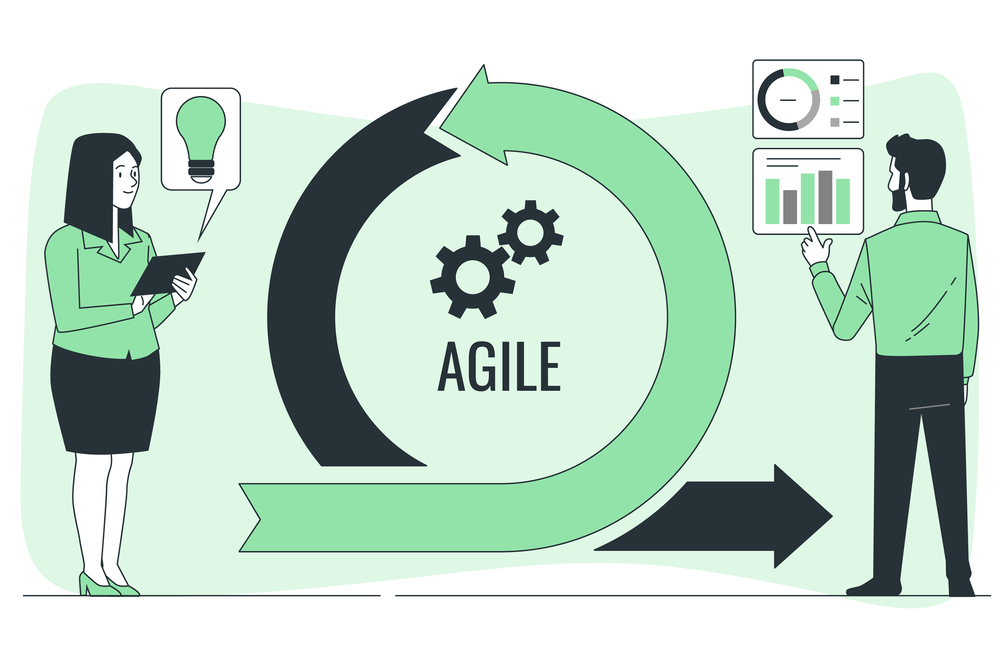Essential Agile Best Practices For Every Agile Team

The information technology industry has been completely transformed by agile methodologies. But what exactly is Agile, you may ask? Agile is a project management methodology characterized by short development cycles known as 'sprints,' aimed at achieving continuous improvement in a product or service. A sprint is a set period during which a team completes a specific task. Each sprint typically concludes with a review where the team assesses their performance and discusses ways to enhance their work.
Agile methodology is widely adopted across various industries focused on building products or services through a cycle of small, continuous changes. Unlike the Waterfall approach, which uses a step-by-step technique for product development, Agile best practices emphasize flexibility with constant updates throughout the process.
According to Capterra, about 71% of organizations today report using agile methodologies for their operations, either occasionally or consistently. Another survey indicates that agile projects are 28% more successful than traditional ones, underscoring the popularity of this approach in product and service development.
In essence, 'Agile Best Practices' is an umbrella term encompassing a range of frameworks and practices that guide these frameworks. Notable project management frameworks within Agile include Scrum, Kanban, Lean, and XP.
Agile Best Practices
Iterative Development
In agile iterative development, large projects are broken down into smaller chunks, and continuous testing is done in repetitive cycles. This approach allows agile teams to identify new features that need to be added to the final product or service, contributing to more flexible product development.
Daily Meetings
Regular, concise meetings are crucial for agile implementation. Each team member should explicitly state their task progress and what needs to be done next. This practice helps monitor team performance and identify any obstacles hindering product development.
Using Professional Tools
Using project management tools aids in better structuring workflows and improving team collaboration. Professional project management software can significantly reduce the effort needed to manage tasks, documentation, and meetings.
One such tool is Stintar, a comprehensive software solution with intelligent features that cover all your agile project management needs.
Agile Best Practices: Scrum Project Management
Scrum is a dominant agile framework, with 58% of organizations implementing it for product development, and 18% using it in combination with other frameworks.
Scrum Best Practices
1. Creating Product Backlog and Product Vision Together: This practice ensures mutual understanding and better alignment between the development team and stakeholders.
2. Use Burndown Charts for Sprints: Burndown charts help monitor sprint progress, visualize work done, and remaining work, and identify potential scope creep.
3. Setting Communication Guidelines for Teams: Establishing a communication strategy with clear guidelines helps ensure seamless communication, particularly for remote teams.
4. Practicing Stand-Ups: Daily 15-minute meetings keep everyone updated on project progress and help track the dos and don’ts of product development.
Agile Best Practices: Kanban Project Management
The Kanban method, originally developed in Japan to control material demand and supply in production lines, is now used for various workflows via defined boards for task lists, such as 'not started,' 'in-progress,' and 'done.'
Kanban Best Practices
1. Visualizing Workflows: Using boards or cards to show task progress helps track tasks and identify hurdles in product development.
2. Limiting Work in Progress (WIP): Setting constraints on WIP helps the team understand what needs to be done within a given timeframe and identify bottlenecks effectively.
3. Continuous Feedback: Regular feedback helps identify and address hurdles in the product development cycle and improve processes.
4. Focusing on Flow: Monitoring work item flow helps the team understand the speed and smoothness of delivery, distinguishing between 'good' and 'bad' flow.
Lean Development Model
Lean project management applies lean manufacturing principles to project management, focusing on eliminating waste and maximizing value.
Lean Best Practices
1. Identifying Value: Break down complex projects into smaller tasks to identify valuable components and eliminate unnecessary ones.
2. Reducing Waste: Eliminate tasks, meetings, or documentation that do not add value, providing clear direction to team members.
3. Continuous Improvement: Constantly seek improvements throughout the project development, clearly communicating requirements and guidelines to achieve more with minimal waste.
Extreme Programming (XP)
Extreme Programming (XP) is an agile framework focused on developing high-quality software while increasing developer productivity and fostering collaboration.
XP Best Practices
1. Planning Game: All team members should participate in the planning process, ensuring no ambiguity between teams working on a project.
2. Test-Driven Development (TDD): Writing tests before code helps identify potential failures, reduces defects, and saves development time.
3. Small Releases: Regular small releases throughout the product development lifecycle help teams understand progress and identify tasks early.
4. Practicing Simple Design: A simple design requires less time to write and fix, reducing overall development costs and encouraging easier solutions.
Conclusion
In conclusion, agile methodologies offer powerful frameworks for managing software development projects. By implementing these best practices—whether through Scrum, Kanban, Lean, or XP—teams can improve efficiency, enhance collaboration, and deliver high-quality products that meet customer needs. The Recap of Agile Best Practices are:
1. Effective Backlog Management: Prioritize and refine tasks to align with goals.
2. Time-Boxed Sprints: Maintain a steady work pace.
3. Regular Communication: Keep team members aligned.
4. Incremental Delivery: Deliver usable products frequently.
5. Continuous Improvement: Regularly review and improve processes.
By adhering to these best practices, agile teams can navigate the complexities of modern software development and deliver exceptional results. Whether you choose Scrum, Kanban, Lean, or XP, the core Agile principles remain the same: flexibility, collaboration, and a relentless focus on delivering value to the customer.